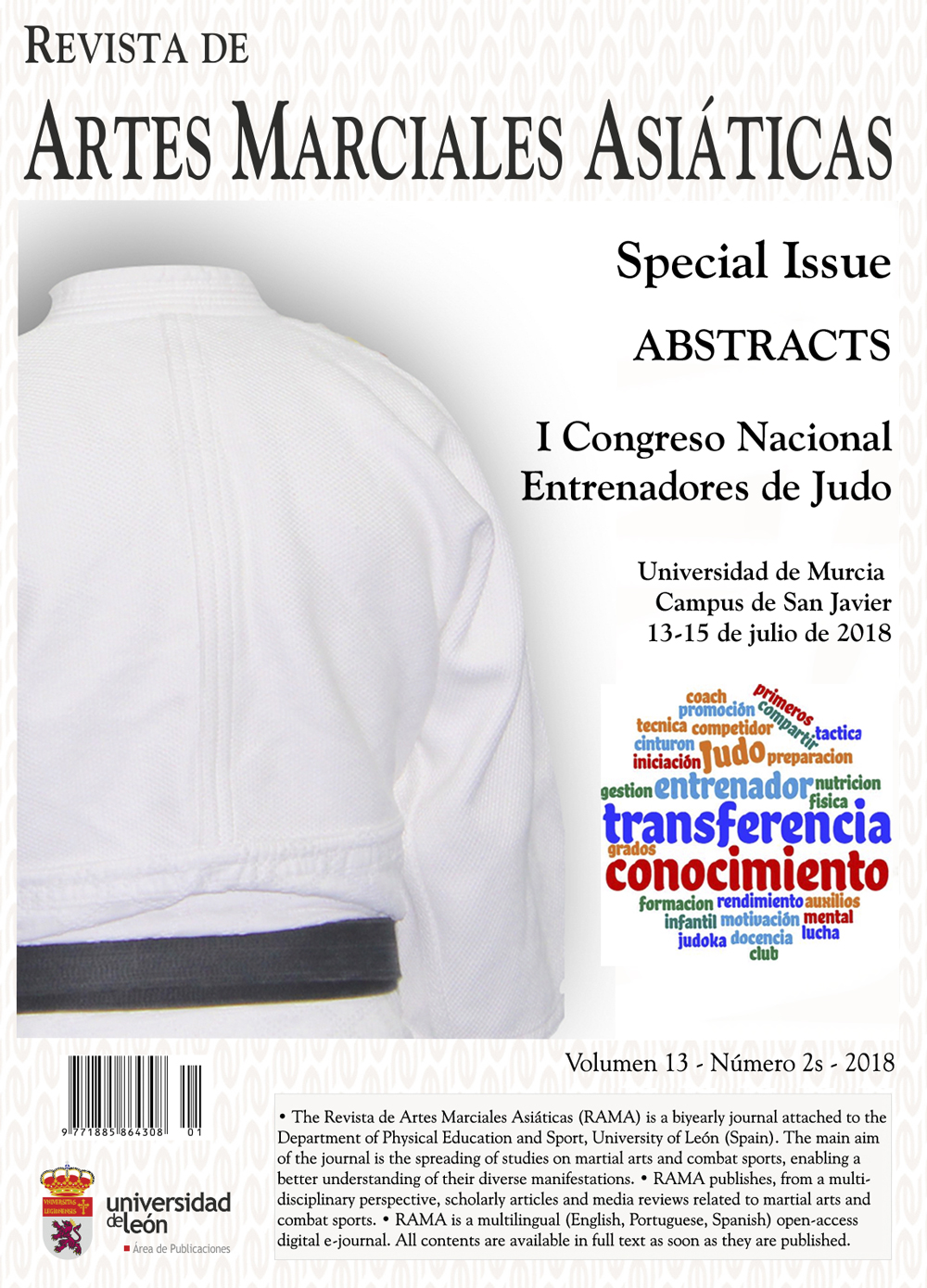Análisis del perfil de flexibilidad en jóvenes taekwondistas
DOI:
https://doi.org/10.18002/rama.v13i2s.5503Palabras clave:
Deportes de combate, taekwondo, rango de movimiento, cortedad, lesiónResumen
El objetivo principal del presente estudio fue determinar el perfil de flexibilidad de la extremidad inferior en atletas jóvenes de taewwondo, así como identificar los deportistas con cortedad muscular. Para ello, un total de 17 taekwondistas jóvenes participaron en el presente estudio; siete deportistas pertenecían a la selección española y diez a la selección Murciana. El rango de movimiento de los principales movimientos de la extremidad inferior fue valorado mediante el protocolo “ROM SPORT” y se realizó un análisis descriptivo de cada una de las variables cuantitativas. Se aplicó la prueba t-test de Student o Wilcoxon dependiendo de la normalidad de los datos. Los valores de ROM de cada movimiento se clasificaron como “normal” o “cortedad” de acuerdo con valores de referencia previamente justificados. Los resultados definen como perfil de flexibilidad en 23º para psoas-iliaco, 28º para piramidal, 37º para gemelos, 42º para sóleo, 46º para aductores, 46º para rotadores externos, 56º para rotadores internos, 77º para aductores monoarticulares, 80º para isquiosurales, 140º para cuádriceps y 145º para glúteo mayor. La medición individual del ROM identificó cortedad muscular en 11 deportistas en piramidal (64,7%), 13 deportistas en sóleo (76,4%), 8 deportistas en rotadores externos (47%), 14 deportistas en aductores monoarticulares (82,3%), 13 deportistas en isquiosural (76,4%), 4 deportistas en cuádriceps (23,5%) y 12 en glúteo mayor (70,5%). Este perfil de flexibilidad puede ayudar a los profesionales del deporte a marcar objetivos cuantificables en el entrenamiento de la flexibilidad en este deporte. La inclusión de estiramientos, o el aumento de la dosis deben de aplicarse sobre las cortedades identificadas en piramidal, sóleo, rotadores externos de cadera, aductores monoarticulares, isquiosural, cuádriceps y glúteo mayor.
Descargas
Métricas alternativas
Citas
Bridge, C.A., Ferreira da Silva Santos, J., Chaabène, H., Pieter, W., & Franchini, E. (2014). Physical and physiological profiles of taekwondo athletes. Sports Medicine, 44(6), 713-33. doi: http://doi.org/10.1007/s40279-014-0159-9
Campos, F.A., Bertuzzi, R., Dourado, A.C., Santos, V.G.F., & Franchini, E. (2012). Energy demands in taekwondo athletes during combat simulation. European Journal of Applied Physiology, 112(4), 1221-1228. doi: http://doi.org/10.1007/s00421-011-2071-4
Cardozo, L. A., Vera-Rivera, D. A., Conde-Cabezas, O. A. y Yánez, C. A. (2017). Aspectos fisiológicos de deportistas elite de taekwondo: Una revisión narrativa. Revista Española de Educación Física y Deportes, (418), 35-46.
Cejudo, A. (2015). Deporte y flexibilidad: Rendimiento deportivo sin riesgo de lesión (Tesis Doctoral). Universidad de Murcia, San Javier, España.
Cejudo, A., Sainz de Baranda, P., Ayala, F. & Santonja, F. (2015). Test-retest reliability of seven common clinical tests for assessing lower extremity muscle flexibility in futsal and handball players. Physical Therapy in Sport, 16(2), 107-113. doi: http://doi.org/10.1016/j.ptsp.2014.05.004
Cejudo, A., Sainz de Baranda, P., Ayala, F. & Santonja, F. (2017). Clasificación de los valores de rango de movimiento de la extremidad inferior en jugadores de fútbol sala. SPORT TK, 6(1), 41-50.
Ellenbecker, T.S., Ellenbecker, G.A., Roetert, E.P., Silva, R.T., Keuter, G. & Sperling, F. (2007). Descriptive profile of hip rotation range of motion in elite tennis players and professional baseball pitchers. The American Journal of Sports Medicine, 35(8), 1371-1376.
Heller, J., Peric, T., Dlouha, R., Kohlíková, E., Melichna, J., & Nováková, H. (1998). Physiological profiles of male and female taekwon-do (ITF) black belts. Journal of Sports Sciences, 16(3), 243-249. doi: http://doi.org/10.1080/026404198366768
Hopkins, W., Marshall, S., Batterham, A.M. & Hanin, J. (2009). Progressive statistics for studies in sports medicine and exercise science. Medicine & Science in Sports & Exercise, 41(1), 3-12. doi: http://doi.org/10.1249/MSS.0b013e31818cb278
López-Valenciano, A., Ayala F., Vera-Garcia, F.J., De Ste Croix, M., Hernández-Sánchez, S., Ruiz-Pérez, I., Cejudo, A. & Santonja, F. (en prensa). Comprehensive profile of hip, knee and ankle ranges of motion in professional soccer players. The Journal of Sports Medicine and Physical Fitness (in press).
Markovic, G., Misigoj-Durakovic, M., & Trninic, S. (2005). Fitness profile of elite Croatian female taekwondo athletes. Collegium antropologicum, 29(1), 93-9.
Pallant, J. (2007). SPSS survival manual: a step by step guide to data analysis using SPSS. 3rd edition. Crows Nest, N.S.W.: Allen & Unwin.
Pion, J., Fransen, J., Lenoir, M., & Segers, V. (2014). The value of non-sport-specific characteristics for talent orientation in young male judo, karate and taekwondo athletes. Archives of Budo, 10, 147-150.
Rivera, M., Rivera-Brown, A., & Frontera, W. (1998). Health related physical fitness characteristics of elite Puerto Rican athletes. Journal of Strength & Conditioning Research, 12(3), 199-203.
Wasik, J. (2009). Structure of movement of a turning technique used in the event of special techniques in Taekwon-do ITF. Archives of Budo, 5, 111-115.
World Taekwondo Federation. (2017). WTF website. Recuperado de www.worldtaekwondo.org
Descargas
Publicado
Cómo citar
Número
Sección
Licencia
Derechos de autor 2018 Antonio Cejudo Palomo, Blanca San Cirilo Soriano, Francisco Javier Robles Palazón, María Del Pilar Saiz De Baranda

Esta obra está bajo una licencia internacional Creative Commons Atribución-NoComercial-CompartirIgual 4.0.
Los autores que publican en esta revista están de acuerdo con los siguientes términos:
- Los autores ceden de forma no exclusiva los derechos de explotación (reproducción, distribución, comunicación pública, transformación) a la Universidad de León, por lo que pueden establecer, por separado, acuerdos adicionales para la distribución no exclusiva de la versión de la obra publicada en la revista (por ejemplo, alojarlo en un repositorio institucional o publicarlo en un libro), con un reconocimiento de su publicación inicial en esta revista.
- Este trabajo se encuentra bajo la Creative Commons Attribution-NonCommercial-ShareAlike 4.0 International License. Puede consultarse desde aquí la versión informativa y el texto legal de la licencia.
- Se permite y se anima a los autores a difundir electrónicamente las versiones pre-print (versión antes de ser evaluada) y/o post-print (versión evaluada y aceptada para su publicación) de sus obras antes de su publicación, ya que favorece su circulación y difusión más temprana y con ello un posible aumento en su citación y alcance entre la comunidad académica.











